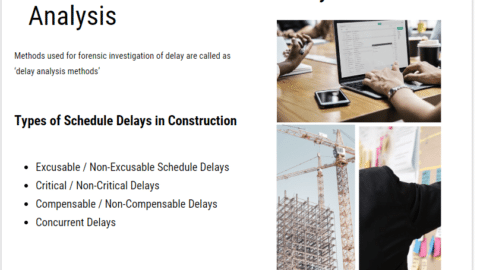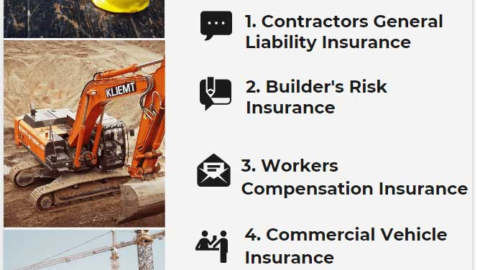Construction Claims Management
What is Claims Management in Construction? In this article, we will discuss Construction Claims Management process, examples of common construction claims, and responses. Typically construction projects involve many resources such as labors, subcontractors, equipment, and materials. Lack of coordination and communication between the project team and the vendors may cause disputes during the execution of the project.
Table of Contents
A number of issues such as unclear scope definition, poorly defined initial requirements, and lack of stakeholder involvement are the most common reasons for disagreements between the parties.
A claim is a demand for something due which results from an action. A claim is different than a change order. A change order is an agreement between the parties however, the claim is a request by one party. The claim becomes a change order if the parties agree. If the claim does not come to an agreement, it may proceed to negotiation, mediation, arbitration, and litigation phases until it is resolved.
What is Claims Management in Construction?
Construction claims management is an indispensable process in today’s projects that involve many resources and parties. One of the most effective claims management techniques to avoid claims in the early phases of a project is eliminating the root causes of problems before they occur.
For example, a well defined technical specification for a material prevents disagreements related to the quality of the material during the execution phase.
It is always easier and cheaper to resolve the issues between the parties at the early stages. As the construction project progresses, changes may become costly and difficult. For that reason, claim management requires to implement effective practices during the entire project life cycle.
Phases of a Construction Project
Typically a construction project has four basic phases.
- Pre Tender: Preparation of concept design and contract documentation.
- Contract Formulation: Preparation and submission of tenders and contract signing.
- Construction: Building & execution of the project
- Post Completion: Completion of the project.
Most of the disputes arise during the construction phase. However, the root causes of the disputes are originated from the poorly managed pretender and the contract formulation phases. So that it is possible to prevent most of the claims by establishing a proper contact management system.
The construction phase makes disputes unavoidable because of its nature. Clients, stakeholders, project teams, and subcontractors often have particular requirements and expectations.
Therefore, during the construction phase, the role of the contract manager is critical in documenting all important events related to disputes. For example, if the process of land handover is completed, then all land-related information, dates, and agreements must be well documented.
Many people think that claims originate from contractor’s needs and contractors often make claims against the client. However, claims may or may not originate from the client’s requirements.
Construction Claims Management Phases
In a construction claims management process, there are two parties. One is making the claim and the other is preventing against it. In construction, additional work or an extra to the contract is subject to a claim.
Basically, claim management phases fall into four categories which are below:
- Prevention
- Mitigation
- Pursuing Claims (Claim Identification and Quantification)
- Resolution
The Claim Prevention phase starts with the initial contract documentation. The most effective way to prevent claims is to create all contract documents, plans, and designs in the same line.
During the construction phase, it is not possible to avoid all the claims but it is possible to mitigate them. For example, well-defined responsibilities, good communication channels, effective risk management, and decision-making help project teams to take preventive actions.
The Claim Pursuing phase includes two subheadings which are Claim identification and Claim Quantification. Claim identification is to identify the possible claims by analyzing the contract documents such as the scope of work, contract terms, extra work descriptions, etc.
Claim quantification is to calculate the cost and time impact of the claim by analyzing the critical path of the schedule and cost estimation documents.
Once the claim is identified and quantified, the claim resolution phase comes into action.
Negotiation between parties is the best solution to a claim resolution. If the claim is not resolved by negotiation, it will proceed to mediation, arbitration, and litigation phases.
Tips For Effective Construction Claims Management
As we discussed above, in a construction project, claim prevention actions can be taken effectively during the pretender and contract formulation phases.
Well created contract documents and design files offer a great opportunity for construction claims prevention. Once the construction phase begins, claim prevention becomes difficult.
Although the impact of claims can be minimized by an effective project and contract management, claims may arise from disputes.
In case of claim occurrence, effective construction claims management must be done in order to avoid potential losses.
The following recommendations can be used for an effective construction claims management process.
1. Review the claim file and supporting documents prepared by the contractor and specify the legal basis of the claim.
2. Perform a site investigation and collect information about utilities, soil conditions, subsurface conditions, general site conditions, labor, weather, material, equipment, and other related items.
3. Analyze the proof submitted by the contractor and decide if it is adequate or not for the assertion.
4. Review the breakdown of the contractor’s bid.
5. Underline the requirements mentioned in the contract for claim preparation and determine the sufficiency of the documents submitted by the contractor.
6. Review the site reports, records, documents to obtain a detailed understanding of the facts. List the facts which can be confirmed or refuted and determine the additional proofs that are required to support the Contractor’s claims.
7. Compare the current schedule with the one submitted by the contractor in the claim file. Analyze the activities and determine the similarities and the discrepancies.
8. Assemble a meeting with the contractor and underline the statements to support factual analysis.
9. Make a productivity analysis of the Contractor’s supporting documentation and compare it with the actual performance records. Analyzing the supporting documentation is very important in construction claims management.
10. Calculate the overhead costs of the contractor by using daily reports.
11. Determine the strengths and weaknesses of the claim.
12. Prepare an action plan for managing and resolving the issue.
Conclusion
Claims management is the process of identifying and evaluating potential claims. Unlike other industries, construction disputes have their own characteristics. Therefore, conflict resolution techniques differ from other industries. The parties involved in any construction project may have conflicts even if they have the same goal. Effective claim analysis and prevention practices are essential for securing projects from damages.
Note that there are many construction claims management courses available as well as online courses. You can participate in one of them to improve your knowledge in that field.
External References
[1] pmi.org
See Also

Victor Z Young is a Civil Engineer with 35 years of experience working alongside the executive team of various construction companies. Victor specializes in construction insurance, delay analysis, performance analysis and engineering. He holds a Doctor of Project Management from Northwestern University.











I like your tip about calculating the cost. That makes sense considering you want to stay within your budget. I’ll have to consider your tips so that I can stay ahead of schedule.
I like your tip about how pro tender is the preparation of concept design and contract documentation. I imagine builders have to focus heavily on this step so that they can have legal protection in the event of an accident or employees quitting. Good thing that construction litigators exist to help managers navigate the legal workings of a site.
Really a piece of great information to read. To renovate something is to alter the current appearance or structural integrity of the entity.
This article provides a comprehensive and insightful overview of the crucial concept of construction claims management. Good Work keep it up!
Irresistible! Thank you so much for this kind and good service.your services is better than better.
Great read. Thank you.
I am interested in construction claims management. I intend to be a specialist in the management of construction claims.
Ejike.